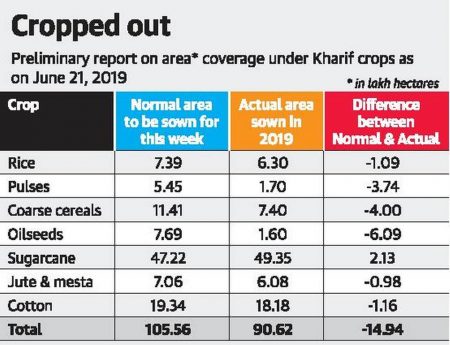Southwest Monsoon 24/06/2019 – Posted in: Daily News – Tags: traditional theory of monsoon
SOUTHWEST MONSOON
For: Mains
Topics covered: SouthWest Monsoon, Delayed and Lower than average, Farmer’s demands, Monsoon related theories, IMD
News Flash
India faces a 38% current rainfall deficit due to late running Southwest Monsoon.
Findings
- According to the Indian Meteorological Department (IMD), the country has only received 43% of the normal monsoon rainfall so far.
- In total, almost 80% of districts face a rainfall deficit of at least 20% below normal.
- According to the Central Water Commission (CWC), 80% of the country’s 91 major reservoirs have below-normal storage.
- 11 reservoirs have no water at all.
Negative Impacts
- Depleted Reservoirs
- Delayed in sowing of summer or Kharif foodgrain crops
- Biggest delays are in pulses and oilseeds
- Parts of central and peninsular India are staring at a drought
Farmer’s demand
- Groups of farmers’ demanding that the government declare drought in affected areas without waiting till the end of the monsoon.
- Drought must be declared in all those districts where sowing has been severely affected owing to 50% or greater deficit in June.
- All India Kisan Sangharsh Coordination Committee, demanded that the Central norms for crop loss compensation (input subsidy) must be revised to at least Rs. 10,000 per acre for un-irrigated land and proportionately higher amounts for irrigated land and horticultural crops.
- Crop insurance must be paid in full and in a timely manner.
- Reserve Bank of India (RBI) must ensure that farmers are not denied credit due to impending drought.
- Government to extend the Mahatma Gandhi National Rural Employment Guarantee Scheme (MGNREGS) from 100 to 150 days of work in drought-affected areas.
SouthWest Monsoon
- It affects the Indian subcontinent, where it is one of the oldest and most anticipated weather phenomena.
- It is an economically important pattern every year from June to September.
- The unique geographical features of the Indian subcontinent, along with associated atmospheric, oceanic, and geophysical factors, influence the behavior of the monsoon.
Traditional Theory: Process of Monsoon creation
- It is also known as the thermal theory or the differential heating of sea and land theory.
- The traditional theory portrays the monsoon as a large-scale sea breeze.
- It states that during the hot subtropical summers, the massive landmass of the Indian Peninsula heats up at a different rate than the surrounding seas, resulting in a pressure gradient from south to north. This causes the flow of moisture-laden winds from sea to land. On reaching land, these winds rise because of the geographical relief, cooling adiabatically and leading to orographic rains. This is the southwest monsoon.
- The southwest monsoon flows from sea to land and carries more moisture.
Source: The Hindu
You can follow us on LinkedIn and for more updates related to UPSC IAS Preparation, Like our Facebook Page and subscribe our Diligent IAS Youtube Channel

